2008-09
Departmental Performance Report
Natural Sciences and Engineering Research Council of Canada
The original version was signed by
The Honourable Tony Clement
Minister of Industry
Contents
2. Analysis of Program Activities by Strategic Outcome
- People: Highly skilled science and engineering professionals in Canada
- Discovery: High quality Canadian-based competitive research in the NSE
- Innovation: Productive use of new knowledge in the NSE
Minister's Message

The past year has been a challenging one for the Canadian economy, as it has been for the economies of all industrialized countries. The global economic crisis put the fiscal and economic frameworks of all countries to the test. But Canada entered the recession with solid fundamentals — balanced budgets, decreasing debt and taxes, a strong financial sector and robust economic policies. Consequently, Canada is in a comparatively good position to effectively respond to this time of economic challenge.
The Industry Portfolio played a significant role in developing Canada’s resiliency and ability to weather the current crisis. Composed of 11 departments, agencies, Crown corporations and quasi-judicial bodies, the Portfolio includes major instruments in the Government of Canada’s tool kit for building a competitive economy.
In 2008–09, such measures included continued commitment to the Natural Sciences and Engineering Research Council of Canada (NSERC), which invested just over $1 billion on its programs during fiscal 2008–09.
In January 2009, the government introduced Canada's Economic Action Plan, which contained stimulative measures to respond to the global recession. Industry Portfolio members played, and will continue to play, a central role in developing and implementing a significant number of these critical initiatives. These measures range from programs to upgrade research infrastructure at Canada's universities and colleges, to helping small businesses bring innovative products to market, to supporting major tourism events, to enhancing community and recreational facilities and other municipal infrastructure in Ontario. For more information, visit the Canada’s Economic Action Plan Web site.
As a country, we are emerging from the recession by creating a climate that encourages innovation, productivity and competitiveness — helping Canadian industry move to the forefront of the global knowledge economy. The Industry Portfolio members, and other federal departments and agencies are working in partnership so that Canada continues to enjoy a high standard of living and a prosperous future.
It is my pleasure to present NSERC’s Departmental Performance Report for 2008–09.
Tony Clement
Minister of Industry
Overview of the Agency
1.1 Summary Information
Raison d’être
The Natural Sciences and Engineering Research Council of Canada (NSERC) works to make Canada a country of discoverers and innovators for the benefit of all Canadians. NSERC aims to maximize the value of public investments in R&D and to advance prosperity and quality of life in Canada by supporting the creation and transfer of knowledge in the natural sciences and engineering (NSE) and by ensuring that people are trained to discover, develop and use that knowledge.
Responsibilities
NSERC is the primary federal agency investing in research and research training in the natural sciences and engineering disciplines. It is funded directly by Parliament and reports to it through the Minister of Industry.
Our mission is to invest in people, discovery and innovation to build a strong Canadian economy and to improve the quality of life for all Canadians. NSERC advances the government’s S&T priorities of building a stronger Canada, creating opportunities for young Canadians and investing in knowledge and creativity.
NSERC was created in 1978. Its legal mandate and functions are defined as follows: “The functions of the Council are to promote and assist research in the natural sciences and engineering, other than the health sciences; and advise the Minister in respect of such matters relating to such research as the Minister may refer to the Council for its consideration.” (Natural Sciences and Engineering Research Council Act, 1976-77, c.24.)
NSERC’s business model includes: a competitive, peer reviewed evaluation system to ensure world class levels of excellence and value for money; a blend of targeted and broad-based programs to ensure that priority research topics are addressed as well as a broad spectrum of science areas; the training of the next generation of scientists and engineers; a suite of collaborative research programs that foster partnerships between industry and post-secondary institutions and that encourage knowledge transfer and commercialization; and appropriate and effective controls that are proven and recognized to ensure accountability.
The agency’s headquarters is located in the National Capital Region, where a majority of the staff are located. NSERC also has regional offices in Vancouver, Winnipeg, Mississauga, Montreal, and Moncton.
S&T Strategy
Through the Federal Science and Technology (S&T) Strategy, Mobilizing Science and Technology to Canada’s Advantage, the federal government has committed to maintaining Canada’s G-7 leadership in public sector R&D performance. The Strategy builds on existing strengths, focusing efforts in areas where Canada can achieve global excellence, to make a real impact on the lives of Canadians and in the marketplace.
The S&T Strategy emphasizes three Canadian advantages: an entrepreneurial advantage that translates knowledge into practical applications; a knowledge advantage that generates new ideas and builds research excellence; and a people advantage that increases and retains the highly skilled individuals that Canada needs to thrive in the global economy. Together these advantages resonate with the mandate of NSERC and its strategic positioning.
NSERC’s focus on people, discovery and innovation maps directly onto the strategy’s emphasis of building a People Advantage, a Knowledge Advantage and an Entrepreneurial Advantage. In broad terms, virtually all of NSERC’s funding relates to these advantages.
Clients and Partners
NSERC is the most important funder of the direct costs of research in the natural sciences and engineering in Canadian universities. NSERC provides nearly one-fifth of the more than $4 billion invested in R&D in the natural sciences and engineering in Canadian universities and colleges.
Nearly 12,000 university professors and more than 28,500 university students and postdoctoral fellows are supported by NSERC. (For a searchable database of all NSERC grant and scholarship recipients see http://www.nserc-crsng.gc.ca/NSERC-CRSNG/FundingDecisions-DecisionsFinancement/index_eng.asp.) NSERC funds are also used to support more than 3,500 university technicians and research associates. Most Canadian universities benefit from NSERC programs, as do a growing number of colleges. Fifteen hundred Canadian companies and some 50 federal and provincial government departments are partnering with NSERC. Detailed statistics on NSERC applications and awards can be found at: http://www.nserc-crsng.gc.ca/NSERC-CRSNG/FactsFigures-TableauxDetailles_eng.asp.
Strategic Outcomes
In order to effectively pursue its mandate, NSERC aims to achieve the following three strategic outcomes.
- People: Highly skilled science and engineering professionals in Canada
- Discovery: High quality Canadian-based competitive research in the NSE
- Innovation: Productive use of new knowledge in the NSE in Canada
Program Activity Architecture
The chart below presents NSERC’s Program Activity Architecture (PAA) in effect in 2008-09.
NSERC’s Program Activity Architecture
| Strategic Outcomes | ||
|---|---|---|
| People Highly skilled science and engineering professionals in Canada |
Discovery High quality Canadian-based competitive research in the natural sciences and engineering |
Innovation Productive use of new knowledge in the natural sciences and engineering |
| Program Activities | ||
| Promote Science and Engineering | Fund Basic Research | Fund Research in Strategic Areas |
| Sub-Activities | Sub-Activities | Sub-Activities |
|
|
|
| Support Students and Fellows | Support for Research Equipment & Major Resources | Fund University-Industry-Government Partnerships |
| Sub-Activities | Sub-Activities | Sub-Activities |
|
|
|
| Attract and Retain Faculty | Support Commercialization | |
| Sub-Activities | Sub-Activities | |
|
|
* Includes Centres of Excellence for Commercialization and Research (CECR), Business-Led Networks of Centres of Excellence (BL-NCE), and the Industrial R&D Internships (IRDI) program.
1.2 Summary of Performance
Financial Resources and Human Resources
| Planned Spending | Total Authorities | Actual Spending |
|---|---|---|
| 999.1 | 1,031.8 | 1,029.8 |
| Planned | Actual | Difference |
|---|---|---|
| 349 | 352 | 3 |
Performance Summary
Given the nature of R&D support programs, the impact of NSERC’s investment in research and training in the NSE can only be fully assessed over the long term. Therefore, the expected results reported in NSERC’s Report on Plans and Priorities 2008-09 should be considered as planned results for the future. The performance information presented in this year’s DPR is a retrospective look at outcomes resulting from NSERC funding over the past decade, and in some cases even longer.
- Source: NSERC PromoScience final reports.
- Sources: NSERC student surveys and Statistics Canada.
- Source: NSERC award management information system.
- Source: NSERC and Observatoire des Sciences et des Technologies.
- Source: Observatoire des Sciences et des Technologies.
- Source: OECD : Main Science and Technology Indicators 2008/2.
- Source: NSERC database of spin-off companies.
- Source: Statistics Canada.
NSERC Links to Government of Canada Outcomes
NSERC investments contribute significantly to many of the Government of Canada’s strategic outcomes. NSERC has chosen to link all of its program activities to the Government of Canada outcome: an innovative and knowledge-based economy which is most directly related to our mandate and activities. Because NSERC funds research and training leading to a wide-range of economic and societal impacts in virtually every sector, many of NSERC’s long-term outcomes are also directly linked to other important Government of Canada outcomes, such as strong economic growth, income security and employment for Canadians, a clean and healthy environment, healthy Canadians with access to quality health care, and safe and secure communities. For simplicity, the “innovative and knowledge based economy” outcome is by far the most appropriate for NSERC to use in linking resources and results.
| Priority | Type | Status | Linkages to Strategic Outcome |
|---|---|---|---|
Foster a People Advantage
|
On-going | Successfully Met NSERC announced $32 million over six years for 20 projects to help science graduates expand their professional and personal skills so they can make a successful transition from the classroom to the workplace. The funding is being provided under the new Collaborative Research and Training Experience(CREATE) Program which gives science graduates the enhanced skills set they need for careers in industry, government or academia. The first awards for the Industrial R&D Internship (IRDI) were made in 2008-09. The program introduces graduate students and postdoctoral fellows to practical business problems and provides them with the opportunity to apply their expertise to address the needs of participating businesses. NSERC launched two new programs to enhance international student experience. The Canada Graduate Scholarships – Michael Smith Foreign Study Supplements (CGS-MSFSS) Program supported high-calibre Canadian graduate students in building global linkages and international networks at research institutions outside of Canada. In addition, the Vanier Canada Graduate Scholarships (Vanier CGS) program was launched to attract and retain world-class doctoral students by offering them a significant financial award to assist them during their studies at Canadian universities. |
Highly skilled science and engineering professionals in Canada Through research and research training, NSERC fosters the development of skilled workers who will become leaders across the private and public sectors. |
Foster a Knowledge Advantage
|
On-going | Successfully Met NSERC introduced this year major enhancements to the Discovery Grants peer review process. These enhancements have created a much more dynamic funding system, with more opportunity for researchers with superior accomplishments and contributions to receive substantial increases. Discovery Grants Accelerator Supplements, valued at 120K over three years, foster research excellence and are awarded to outstanding researchers who have a well-established research program. Out of the 100 supplements awarded this year, more than two-thirds fall in areas identified as a priority in the science and technology (S&T) strategy. As part of efforts to optimize the effectiveness of federal funding for post-secondary research, the three granting agencies studied recent trends in the balance of funding between elements such as funding for researchers, funding for the direct and indirect costs of the research they perform and for research infrastructure. The balance of federal funding between the different categories has changed considerably during the last decade. In relative terms, support for the direct costs of research has decreased while support for people and infrastructure has increased. Discussions with stakeholders pointed to the need to analyze pressure points and whether there are gaps to sustaining a healthy system, as well as looking at international comparisons. This work continues in the context of the on-going planning of strategic directions and the allocation of NSERC’s budget to its various programs. |
High quality Canadian-based competitive research in the natural sciences and engineering NSERC is committed to creating a strong foundation for research and research training in Canada. This is embodied in NSERC’s Discovery Grants Program, which provides a base from which researchers can establish and build their research programs, and gives them the opportunity to unleash their creative power. |
Foster an Entrepreneurial Advantage
|
On-going | Successfully Met A draft Strategic Plan for Partnership Programs was completed and consultations on an action plan are currently underway. NSERC has also introduced a new A new policy on intellectual property (IP) was adopted that allows for more flexible access to IP developed as a result of NSERC funding, while at the same time ensuring that the rights of all participants are protected. NSERC announced the expansion of its College and Community Innovation (CCI) program and the results of the first CCI competition. Eight projects were funded, each receiving $2.3 million over five years. Many new initiatives were established during the year or early in the new year in government priority areas including:
NSERC also announced $145 million in funding over five years for the establishment of Automotive Partnership Canada, an automotive research fund designed to keep the Canadian auto industry competitive and sustainable. Automotive Partnership Canada involves funding from NSERC, NRC, CFI, SSHRC, and the CECR program. |
Productive use of new knowledge in the natural sciences and engineering in Canada NSERC aims to maximize the value of public investments in research for the benefit of all Canadians by promoting research-based innovation, university-industry partnerships, technology transfer activities. |
| Priority | Type | Status | Linkages to Strategic Outcome(s) |
|---|---|---|---|
Enhance Performance Measurement, Accountability and Value for Money
|
On-going | Successfully Met The tri-Council working group along with CFI have established a common set of indicators, completed data collection and expect to issue a performance report before the end of the year. The merger of audit functions for NSERC and SSHRC has been completed and a new Director of Audit has been hired. The three granting agencies plus the CFI have created several interagency working groups to look into a variety of issues related to alignment and harmonization of agency programs, policies and processes. Some achievements are as follows:
|
All Strategic Outcomes
|
Increase the Visibility of Canadian NSE Research
|
On-going | Successfully Met
Regional offices now have a Communications and Promotion specialist. Each regional office also operates a Regional Opportunity Fund to facilitate the initiatives of others in science and research celebration and promotion. NSERC, NRC-IRAP and the BDC continue to work together on several initiatives. For example, NSEERC-Prairies completed a pilot "Innovation Supports Workshops" aimed at promoting NSERC, NRC, BDC and other federal commercialization support to business, government and academic communities. Workshops were held in Winnipeg, Calgary, Edmonton and Saskatoon and in Atlantic Canada (1 per Atlantic province). |
All Strategic Outcomes A variety of recent studies have concluded that NSERC is extremely well-known in the academic community, but its profile in other sectors and in the general public is modest. The ongoing work to improve our communications products will help to demonstrate the value of NSERC funding. |
Risk Analysis
While NSERC administers a significant budget, the Council’s overall risk level compared to other government entities is considered low, in terms of continuity of government operations and the maintenance of services to, and protection of interests of, the Canadian public. This assessment of risk level is further supported by the Blue Ribbon Panel report on Grants and Contributions which stated, "The record of performance by the federal research granting agencies, including CFI, has been deemed high by international standards. The two councils and CIHR have successfully managed their own research portfolios, using a rigorous system of oversight, including detailed memorandum of understanding signed by all recipient institutions and regular financial monitoring visits of recipient universities."
NSERC last undertook a risk assessment exercise in 2006 as part of the development of the RMAF/RBAF. This exercise identified 20 risks, which primarily relate to internal management processes. In 2008-09, NSERC undertook a process to renew the Corporate Risk Profile to ensure that the risks identified in 2006 are still relevant. Internal Audit Division and the Chief Audit Executive facilitated a process with senior management to provide advice and assistance in the development and implementation of the risk management process. The approved process included:
- Identifying and documenting the “risk universe” that represents the logical categorization and documentation of risks to enable effective risk management;
- Identifying all high impact risk areas and assess these for vulnerability (likelihood of occurrence);
- Preparing mitigation plans/activities designed to reduce the resultant level of risk exposure;
- Establishing ongoing monitoring and reporting requirements; and,
- Formalizing the risk management process to document the methodology that will be adopted for the ongoing identification, assessment, evaluation and management of risk.
This work has begun and will be completed by December of 2009.
Expenditure Profile
During the 2008-2009 fiscal year, NSERC spent $1,029.8 (including the Employee Benefit Plan) million in order to meet the expected results of its program activities and contribute to its strategic outcomes.
The figure below illustrates NSERC’s spending trend from 2006-2007 to 2008-2009. For the 2006-2007 and 2007-2008 periods, all figures appear as reported in previous Departmental Performance Reports.
Spending on NSERC’s core programs increased in the last two years due to $43 million received in Budget 2007(including funding for the Alexander Graham Bell Canada Graduate Scholarships program) and an additional $34 million received in Budget 2008.
In addition to the core funding increases, NSERC received and spent $57 million in 2007-2008 and $19 million in 2008-2009 for the Centres of Excellence for Commercialization and Research (CECR) program, $12 million for the International Polar Year Program in 2007-2008, $2.1 million for the College and Community Innovation Program, $4.3 million for the Industrial Research Internship Program and $7 million for the Business-Led Networks of Centres of Excellence in 2008-2009.
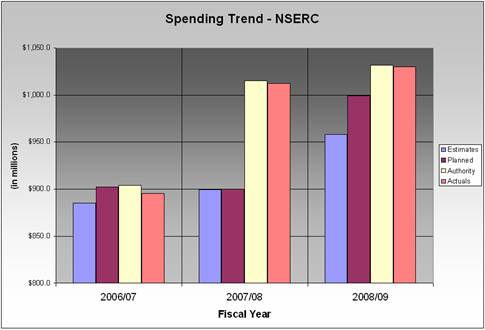
Voted and Statutory Items
The table illustrates the way in which Parliament approved NSERC’s resources.
($ millions)
| Vote # or Statutory Item (S) | Truncated Vote or Statutory Wording | 2006-07 Actual Spending |
2007-08 Actual Spending |
2008-09 Main Estimates |
2008-09 Actual Spending |
|---|---|---|---|---|---|
| 70 | Operating expenditures | 36.5 | 39 | 40.7 | 43.7 |
| 75 | Grants and contributions | 855.2 | 969.6 | 913.4 | 981.8 |
| (S) | Contributions to employee benefit plans | 3.7 | 3.9 | 4.1 | 4.3 |
| Total | 895.4 | 1,012.5 | 958.2 | 1,029.8 | |
Section 2:
Analysis of Program Activities by Strategic Outcome
Strategic Outcome:
Highly Skilled Science and Engineering Professionals in Canada
By supporting 28,000 students and fellows at Canadian universities and abroad, providing programs to support university faculty, and promoting science and engineering to Canadian youth, NSERC will ensure a reliable supply of highly qualified personnel (HQP) for Canadian industry, government, and academia. The following provides details of NSERC’s performance for the three program activities that fall under this strategic outcome.
Program Activity Promote Science and Engineering
| Description: This program activity encourages popular interest in science, math and engineering and aims to develop science, math and engineering abilities in Canadian youth. | ||
|---|---|---|
| Expected Result: Student interest in research in the sciences, math and engineering is encouraged. | ||
| Indicators | Results | Performance Status |
|
|
|
| Financial Resources ($ millions) 2008-09 |
Human Resources (Full-Time Equivalents) 2008-09 |
||||
|---|---|---|---|---|---|
| Planned Spending |
Total Authorities |
Actual Spending | Planned | Actual | Difference |
| 6.3 | 6.3 | 4.7 | 3 | 2 | -1 |
To help improve the interest of Canadian youth in science and engineering, NSERC has invested in two programs: PromoScience and the Centres for Research in Youth, Science Teaching and Learning.
PromoScience provides support to non-profit and public organizations that work with young Canadians in order to build their interest in science and engineering, motivate and encourage their participation in science and engineering activities, and train teachers who are responsible for the science and math education of young Canadians. The program is allowing organizations to expand their offerings and to engage many more young Canadians, especially girls and aboriginal youth. This is critical as young Canadians are less inclined to select science or engineering as a discipline when they enter university (see Figure 2.1) as compared to many other nations.
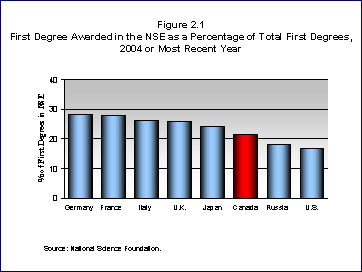
Society for Canadian Women in Science and Technology (SCWIST)
The Society for Canadian Women in Science and Technology (SCWIST), a non-profit organization, runs the ms infinity (math + science = infinite options) program that connects young women with positive female role models who are pursuing dynamic careers and education in S&T and encourages them to continue studying math, science and technology throughout secondary school to broaden their career opportunities. As a result of NSERC funding, 728 girls from across British Columbia participated in hands-on workshops, tele-mentoring, networking and community group science days throughout 2008. Through the varied activities, the participants learned many valuable lessons about schooling and career options and had the opportunity to connect their dreams with a role model.
The CRYSTAL Pilot Program was created in October 2003. CRYSTAL provides a forum for the many partners who share an interest in developing and enhancing the skills of, and resources available to, science and mathematics teachers, and in enriching the preparation of Canadian children in these foundation subjects. The pilot program provided funding to five Centres. Findings from a recent evaluation were as follows:
- The program has increased the scale and changed the nature of research activities in science, mathematics and technology education.
- CRYSTAL is increasing the understanding of ways to improve science, mathematics and technology education for both researchers and teachers. Collaborations between researchers and teachers have increased understanding of the need, and how best, to improve the teaching of science and mathematics.
- The program has increased knowledge translation and outreach activities, with the Centres having undertaken a wide variety of activities with most activities focused on reaching teachers. By the end of the third year, Centres had conducted an estimated 677 knowledge translation activities targeting teachers and developed approximately 479 knowledge translation tools for teachers.
NSERC prizes are also a component of this program activity. NSERC prizes recognize outstanding individual Canadian researchers, research teams and students. They enhance the career development of outstanding and highly promising scientists and engineers and distinguish the sustained excellence of faculty members at Canadian universities. They also publicly recognize lasting partnerships in R&D between university and industry and celebrate young Canadian entrepreneurs.
To recognize the important achievements of Canadian research scientists and engineers, and in the process, to help retain faculty in Canada, NSERC awards significant research prizes to individuals and teams. The 2008-09 winner of NSERC’s Gerhard Herzberg Canada Gold Medal for Science and Engineering is highlighted below.
University of Ottawa and National Research Council
When it comes to stop-action photography, Paul Corkum has left an indelible mark on the world. He is credited with developing attosecond laser pulses—flashes of light so short (one billionth of a billionth of a second) that they can provide images of electrons moving around atoms.
This technology offers unprecedented access to the sub-atomic world and is just the latest of a long string of achievements that have earned Dr. Corkum the Gerhard Herzberg Canada Gold Medal for Science and Engineering.
For more than 30 years, he has pushed the boundaries of human understanding of how light and matter interact. His accomplishments have consistently drawn high praise from his peers around the world.
Manipulating electrons in attosecond time could potentially allow scientists to control and change chemical reactions in new ways, leading to advances in everything from medicine to engineering. The next steps in combining the very fast with the very small, Dr. Corkum believes, will one day help medical researchers advance their understanding of cell processes, something that could enhance drug delivery. It will also provide new tools and new fabrication methods for nanotechnology and new sub-cellular imaging methods.
Program Activity Support Students and Fellows
| Description: This program activity supports the training of highly qualified personnel through scholarship and fellowship programs. | ||
|---|---|---|
| Expected Result: A supply of highly qualified people with leading-edge scientific and research skills for Canadian industry, government, and universities. | ||
| Indicators | Results | Performance Status |
|
|
|
| Financial Resources ($ millions) 2008-09 |
Human Resources(Full-Time Equivalents) 2008-09 |
||||
|---|---|---|---|---|---|
| Planned Spending |
Total Authorities |
Actual Spending | Planned | Actual | Difference |
| 146.2 | 157.8 | 151.4 | 59 | 58 | -1 |
1. NSERC conducts several surveys of its scholarship and fellowship recipients and is able to assess performance against expected results. In addition, Statistics Canada collects labour market information that provides ample evidence of the successful career outcomes of NSE graduates. The indicators present data from 1,850 respondents for a 49% response rate to surveys of students 9 years after their award.
NSERC provides direct financial support to students from the undergraduate to postdoctoral levels through key programs such as:
- Undergraduate Student Research Awards: Held in university (4,639) or industry laboratories (765), this program provides funding for an undergraduate student to spend a four-month work term in a university or industrial research environment.
- Postgraduate Scholarships: At the master’s (1,274) and doctoral (1,651) levels, NSERC supports students by providing an annual stipend that enables them to continue to pursue their research interests. Up to four years of support is available over the course of a candidate’s graduate studies. Opportunities for study at institutions in Canada and abroad as well as at Canadian industrial laboratories (551) are available. Canada Graduate Scholarships (tenable only at Canadian universities) are awarded to the most outstanding candidates (1,525).
- Postdoctoral and Industrial R&D Fellowships: These two-year awards support researchers who have completed their Ph.D., and provides them with funds to continue their programs of research. The awards may be held at any academic institution through a Postdoctoral Fellowship (487), or at a Canadian company that conducts research through an Industrial R&D Fellowship (177).
NSERC also funds students and fellows through support provided by an NSERC-funded professor from his or her NSERC grant. The training of 17,000 students is supported in full or in part through this route.
Since 1978, NSERC has supported the training of more than 80,000 master’s and doctoral students in the NSE. General macro-level economic outcomes for university graduates in the natural sciences and engineering provide ample evidence of the positive outcomes for NSERC-funded students, both directly and indirectly supported. As Figure 2.2 demonstrates, unemployment levels for persons seeking work in natural science or engineering occupations are considerably below national levels; annual salaries for this group are nearly one-third greater than the national average; and employment opportunities continue to grow as the natural science and engineering labour force surpasses the 1,000,000 mark resulting in the fastest growing occupational group over the past 20 years.
(2009 Survey)
- “NSERC was invaluable to my education. It was allowed me to explore R&D to great success and I have developed several ideas into patents and/or products.”
- “The funding I received through NSERC provided an opportunity for me to continue my education past what would have otherwise been possible. It was very beneficial to my personal and career development.”
- “My NSERC scholarship was absolutely critical to my career; it allowed me to pursue training in a top level laboratory. I would not be where I am today without it!!!”
- “The NSERC scholarship was the main reason for pursuing grad studies. It is definitely a valuable program that should be continued to help future grads. At the time it was very prestigious to have an NSERC scholarship.”
- “Receiving an NSERC scholarship was a vitally important part of my graduate studies. Not only did it benefit me directly, but it freed my research supervisor to use his grant funds on additional students and supplies that he would not have been able to afford had my salary been drawn from his grants.”
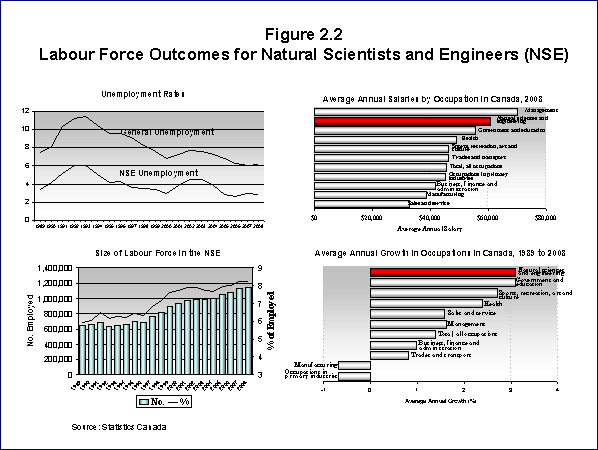
Program Activity Attract and Retain Faculty
| Description: This program activity aims to attract and retain faculty. | ||
|---|---|---|
| Expected Result: Enhanced research capacity in science and engineering. | ||
| Indicators | Results | Performance Status |
|
|
|
| Financial Resources ($ millions) 2008-09 |
Human Resources (Full-Time Equivalents) 2008-09 |
||||
|---|---|---|---|---|---|
| Planned Spending |
Total Authorities |
Actual Spending | Planned | Actual | Difference |
| 167.7 | 169.3 | 152.8 | 25 | 23 | -2 |
Key programs under this program activity include:
- Canada Research Chairs: This tri-agency (NSERC, CIHR and SSHRC) program provides financial support for up to 2,000 professors across Canada, including 900 positions within the NSE. The key objective of this program is to enable Canadian universities to achieve the highest levels of research excellence and to become world-class research centres in the global knowledge-based economy.
- Industrial Research Chairs (IRC), Other Chairs and Faculty Support Programs: The IRC program helps universities build the critical mass of expertise and long-term relationships with corporate partners in areas of research that are of importance to industry. Industrial Research Chairs can also enhance the ability of universities to recruit senior-level researchers and research leaders from industry or other sectors.
Figure 2.3 presents the number of new applicants to NSERC’s largest program, the Discovery Grants program, who received both their bachelor’s and Ph.D. degrees outside the country (this number is a good proxy for an overall evaluation of the “attraction” activity since the vast majority of new professors in the natural sciences and engineering apply to the program). As the figure indicates, Canadian universities continue to attract hundreds of foreign educated personnel every year to become professors. More than 30% of the large number of first-time NSERC applicants are foreign educated. Recent investment by the government in university research has created an attractive environment to conduct research and highly trained people from other countries are coming to Canada to pursue their career.
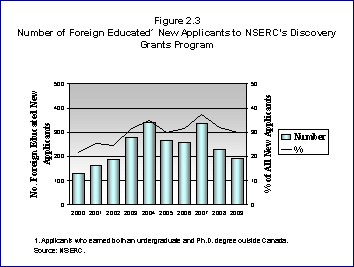
The Canada Research Chairs program has helped to create a research environment that is conducive to the long-term retention and attraction of top researchers. A significant number of Chairholders has been attracted from outside Canada and many top Canadian scientists have stayed in the country as a result of Chair support. Figure 2.4 presents the percentage of external recruits awarded a Canada Research Chair in the natural sciences and engineering since the program’s inception.
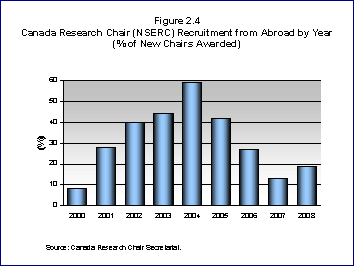
NSERC also tracks the reasons grantees provide when they terminate their awards before the end date. As shown in Figure 2.5, only a small number of professors receiving NSERC support listed “leaving the country” as the reason for terminating their award over the past decade. The number of NSERC-funded professors leaving the country is an extremely small percentage of the nearly 12,000 professors receiving NSERC support each year and is much smaller than the number of new professors attracted to Canada each year (see Figures 2.3 and 2.4).
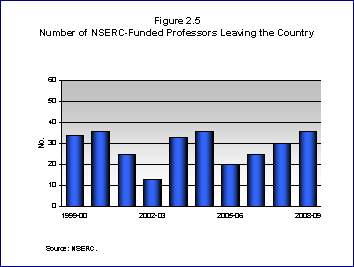
One of the 29 new Industrial Research Chairs in 2008-09 was awarded to Anthony Yeung of the University of Alberta for his work related to the oil sands. A profile of Dr. Yeung’s Chair is presented below:
NSERC/Imperial Oil/Alberta Ingenuity/AERI Industrial Research Chair in Non-Aqueous Bitumen Extraction
The oil sands deposits in northern Alberta, with 175 billion barrels of oil that is recoverable using current technology, is the world’s second largest proven oil reserve (second only to Saudi Arabia). By year 2020, it is expected that the global supply of conventional oil will begin to decline. This will coincide, in marked contrast, to the continuous expansion of Canada’s oil sands industry. It is clear that, in the decades to come, the Canadian oil sands will be a major force in the world energy market. Unfortunately, the current method of extracting heavy oil from the sands, although viable, is impacting negatively on the environment. One of the major concerns is the high demand for fresh water from nearby lakes and rivers.
For the oil sands industry to be sustainable, it is imperative that novel “non-aqueous extraction technologies” be developed (methods of recovering heavy oil from the sand using very little or no water). The proposed Chair program, which is sponsored by Imperial Oil, Alberta Ingenuity and the Alberta Energy Research Institute, will spearhead such an endeavour. In particular, it will tackle the two major challenges that any non-aqueous process will inevitably encounter: the separation of fine solids from solvent-diluted heavy oil, and the recovery of residual hydrocarbon from reject sand grains. This research will focus on the basic science which underlies these challenges, invoking advanced principles of theoretical physics and colloid science. Results from this research will constitute the foundational knowledge that is essential to the design and commercialization of future non-aqueous extraction processes.
Strategic Outcome:
High Quality Canadian-Based Competitive Research in the NSE
Basic research provides the foundation for all scientific and technological advances, and also trains the people who can generate new knowledge in Canada and understand new knowledge generated around the world. The following provides details of NSERC’s performance for the two program activities that fall under this strategic outcome.
Program Activity Fund Basic Research
| Description: This program activity invests in discovery through grants focusing on basic research activities. | ||
|---|---|---|
| Expected Result: The discovery, innovation and training capability of university researchers in the natural sciences and engineering is enhanced by the provision of support for on-going programs of basic research. | ||
| Indicators | Results | Performance Status |
|
|
|
| Financial Resources ($ millions) 2008-09 |
Human Resources (Full-Time Equivalents) 2008-09 |
||||
|---|---|---|---|---|---|
| Planned Spending |
Total Authorities |
Actual Spending | Planned | Actual | Difference |
| 379.4 | 381.3 | 375.6 | 122 | 127 | +5 |
The main program under this activity is the Discovery Grants program. This program is the mainstay of support for university-based research. The program provides funding for ongoing programs of research. Researchers are free to work in the mode most appropriate for the research area and they may pursue new research interests provided they are within NSERC’s mandate. To be funded, they must demonstrate both research excellence and high productivity, and contributions to the training of HQP.
One of the first tangible outcomes of an investment in university R&D is a publication in a scientific or engineering journal. Since the vast majority (nearly 90%) of Canada’s scientific and engineering publications are produced by university researchers, publications are a good indicator of the immediate outcome from NSERC research funding and can be used to benchmark our performance against the rest of the world.
Canada is among an elite group of countries publishing a significant number of articles in science and engineering journals. Since the beginning of the century, Canadian researchers (all sectors) in the natural sciences and engineering (NSE) have increased their annual production of publications from roughly 20,000 per year to current averages of approximately 25,000 publications per year, as shown in Figure 2.6. Overall, Canada’s world share of NSE papers stood at 4.4% in 2007, ranking eighth in the world.
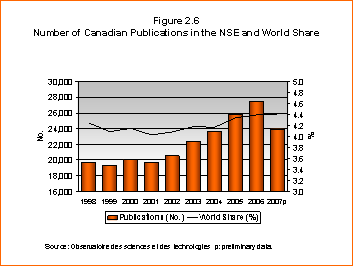
Indicators of productivity as they relate to scientific publication production can also be useful. One indicator is a measure of a country’s output of NSE publications per capita population. Figure 2.7 presents the 2007 per capita output per one million inhabitants for the G8. Using this criterion, Canada has the highest per capita output.
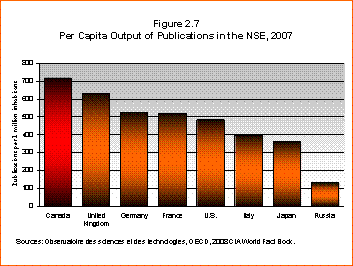
Similar to common rating systems, in which a higher score indicates more viewers, listeners or readers, citations are a measure of the potential use of a researcher’s work by fellow researchers. If a researcher’s work is being referenced or cited more often by his/her peers, then there may be more intrinsic value to the work. Based on the number of citations received by papers over the three years following the publication year, a standardized measure called the Average Relative Citation Factor (ARC) is then calculated for each country and field and normalized to 1.0 to indicate the world average. Figure 2.8 presents the ARC values for the G8 in the NSE in 2007. Canada’s ARC in the NSE ranks 5th and is only slightly behind the top four countries.
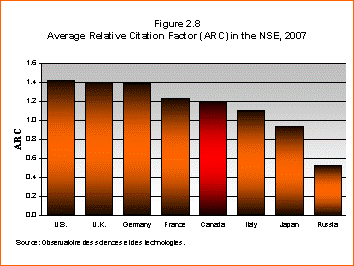
In 2007, member countries of the Organization for Economic Co-operation and Development (OECD) spent $180 billion on university research. Canadian university professors and students performed 6.1% of this total. When measured as a percentage of GDP, Canada spends more on university research than all of its G8 competitors (see Figure 2.9).
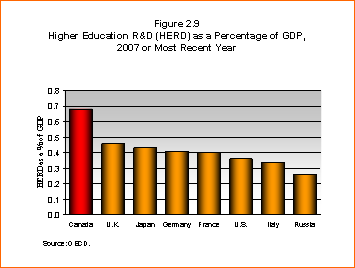
Program Activity Support for Research Equipment and Major Resources
| Description: This program activity helps to support the establishment, maintenance and operation of the research equipment, major research resources and research capacity necessary to carry out high quality research in the natural sciences and engineering. | ||
|---|---|---|
| Expected Result: The discovery, innovation and training capability of university researchers in the natural sciences and engineering is supported by the access to research equipment and major regional or national research facilities. | ||
| Indicators | Results | Performance Status |
|
|
|
| Financial Resources ($ millions) 2008-09 |
Human Resources (Full-Time Equivalents) 2008-09 |
||||
|---|---|---|---|---|---|
| Planned Spending |
Total Authorities |
Actual Spending | Planned | Actual | Difference |
| 41.5 | 54.4 | 76.5 | 23 | 23 | 0 |
The key programs under this program activity are:
- Major Resources Support (MRS): The MRS program supports researchers’ access to major regional or national research facilities by assisting these facilities to remain in a state of readiness for researchers to use. This program is the vehicle for NSERC investments in facilities such as the Canadian Light Source synchrotron in Saskatoon and the Sudbury Neutrino Observatory.
- Research Tools and Instruments Grants (RTI): CFI funding enhances the laboratory setting by funding major equipment and infrastructure purchases. RTI grants enable professors to purchase the smaller pieces of laboratory equipment necessary to conduct world-class research. This critical source of funding ensures researchers have access to the modern research tools required to ensure the maximum return on other investments in research, such as Discovery Grants.
Some of the major findings from a recent evaluation of NSERC’s Research Tools and Instruments (RTI), and the Major Resources Support (MRS) programs are presented below:
- RTI funding leads to more, faster and more in-depth research as well as better trained HQP. These impacts were felt across the spectrum of disciplines, in all regions and in large and small institutions. These observations support the notion that the RTI program is achieving its objectives to enhance the discovery, innovation and training capability of university researchers.
- Three key messages from this evaluation study were:
- a significant proportion of the existing equipment infrastructure will require replacement over the coming five years — between one quarter and one third of the value of existing equipment is at play;
- about 20% of existing equipment will require major maintenance over the coming five years; and
- it is difficult for researchers to find funding for small equipment and NSERC is a major source.
- As NSERC’s RTI grants are capped at $150,000 and with most of the awards less than $80,000, there is currently little overlap between NSERC’s RTI program and Canada Foundation for Innovation (CFI) grants. In fact, constraints to usage of CFI (large-scale, state-of-the-art projects within university strategic priorities) make unlikely a dramatic overlap in financial support with RTI/MFA/MRS projects. The current MRS program complements CFI funding for several facilities (e.g., Canadian Light Source) by providing the necessary operating and maintenance support to fully utilize the facilities.
- The key impacts of the MRS program were identified as better use of the facilities, increased collaboration among researchers and improved international competitiveness of Canadian researchers.
Strategic Outcome:
Productive Use of New Knowledge in the NSE
Wealth is created when Canadians add value in producing goods and services that are sold in world markets and knowledge is the modern basis for adding value. NSERC aims to maximize the value of public investments in research for the benefit of all Canadians by promoting research-based innovation, university-industry partnerships, knowledge and technology transfer activities and the training of people with the required scientific and business skill sets to create wealth from new discoveries in the NSE. The following provides details of NSERC’s performance for the three program activities that fall under this strategic outcome.
Program Activity Fund Research in Strategic Areas
| Description: This program activity funds research in areas of national importance and in emerging areas that are of potential significance to Canada. | ||
|---|---|---|
| Expected Result: Research and training in targeted and emerging areas of national importance is accelerated. | ||
| Indicators | Results | Performance Status |
|
|
|
| Financial Resources ($ millions) 2008-09 |
Human Resources (Full-Time Equivalents) 2008-09 |
||||
|---|---|---|---|---|---|
| Planned Spending |
Total Authorities |
Actual Spending | Planned | Actual | Difference |
| 104.5 | 116.6 | 84.3 | 36 | 35 | -1 |
The key programs under this activity and the Strategic Partnerships are:
- Strategic Project Grants: This program accelerates research and training in targeted and emerging areas of national importance. The research is early-stage with the potential to lead to breakthrough discoveries. The program target areas coincide extremely closely to the government’s current priority areas of the environment, energy, information and communications technologies, manufacturing, automotive applications, forestry, fisheries, and health.
- Strategic Network Grants: This program funds large scale, complex research programs that involve multi-sectoral collaborations on a common research topic. The topic to be investigated can be of local concern, requiring a focused local network, or of regional or national importance, requiring a larger, more complex network.
The Strategic Partnerships Programs are designed to focus on priorities (NSERC Strategic Target Areas) and so provide an excellent framework to implement the S&T Strategy. An analysis of the 2008-09 Strategic Partnerships Program grants indicated that more than 90% of program funding was devoted to government priority areas.
In 2008-09, a total of $47.3M was leveraged from partners in Strategic Partnerships grants versus NSERC’s funding of $84.3M. Given the pre-competitive nature of Strategic Partnership grants, the resulting leverage ratio of 56% indicates excellent partner participation. The number of industrial partners in these programs continues to grow and in 2008-09 stood at 487, for a 40% increase over the past five years (see Figure 2.10).

In a five-year follow-up of NSERC’s Strategic Project grants, interviews were conducted with a total of 127 partners (67% response rate) from either industry or government. Some of the highlights from the survey are presented below:
- Almost all respondents indicated that their Strategic Project grant experience had been worthwhile (i.e., 99.6% of university researchers, 95.7% and 100% of industry and public sector partners respectively).
- Figure 2.11 presents the benefits industry and government partners realized from their participation on the Strategic Project grant.
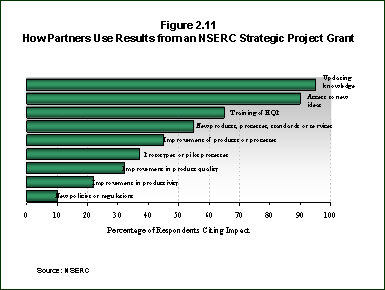
Program Activity Fund University-Industry-Government Partnerships
| Description: This program activity fosters collaborations between university researchers and other sectors, including government and industry, in order to develop new knowledge and expertise, and to transfer this knowledge and expertise to Canadian-based organizations. | ||
|---|---|---|
| Expected Result: Mutually beneficial collaborations between the private sector and researchers in universities, resulting in industrial or economic benefits to Canada. | ||
| Indicators | Results | Performance Status |
|
|
|
| Financial Resources ($ millions) 2008-09 |
Human Resources (Full-Time Equivalents) 2008-09 |
||||
|---|---|---|---|---|---|
| Planned Spending |
Total Authorities |
Actual Spending | Planned | Actual | Difference |
| 139.5 | 131.7 | 168.9 | 77 | 71 | -6 |
The key programs under this program activity are:
- Collaborative Research and Development (CRD) Grants: This program gives companies operating from a Canadian base access to the unique knowledge, expertise and educational resources available at Canadian postsecondary institutions and offers opportunities for mutually beneficial collaborations that result in industrial or economic benefits to Canada.
- Networks of Centres of Excellence (NCEs): The Networks of Centres of Excellence (including the Business-Led Networks) are unique partnerships among universities, industry, government and not-for-profit organizations aimed at turning Canadian research and entrepreneurial talent into economic and social benefits for all Canadians. These nationwide, multidisciplinary and multi-sectoral research partnerships connect excellent research with industrial know-how and strategic investment. They create a critical mass of research capacity by networking researchers and partners across Canada.
- Centres of Excellence for Commercialization & Research: The program funds world-class centres to advance research and facilitate commercialization of technologies, products and services. These centres operate in the priority areas of the S&T Strategy: information and communications technology, environment, energy and natural resources, and health.
The Collaborative Research and Development (CRD) program is intended to give companies operating from a Canadian base access to the special knowledge, expertise and educational resources at Canadian postsecondary institutions and to offer opportunities for mutually beneficial collaborations that result in industrial or economic benefits to Canada. The industrial partners also contribute financially to the university research projects. A comparison of NSERC funding to industry contributions for the CRD program is presented in Figure 2.12.
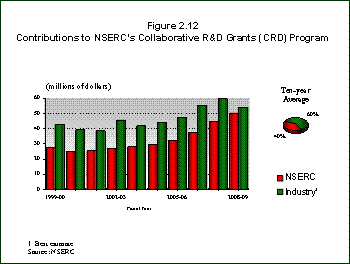
NSERC tracks the outcomes of its Collaborative Research and Development (CRD) program by following-up with researchers and partners. Results from the latest follow-ups are described below:
- CRD reports required an overall ranking to assess the extent to which overall objectives of the program were achieved. The answers were rated on a scale of 1 to 7 where 1 meant “not at all”, the midpoint indicated “somewhat” and 7 indicated “to a great extent.” 74% of reports responded with scale 6 and 7 indicating that objectives and milestones were achieved to a large extent. There were no responses that indicated that objectives were “not met at all”.
- Out of 276 reports, 49% of the projects reported contribution to new products or processes and 67% of projects reported contribution to improved products or processes.
- There were 18 new licenses generated and 103 patents had been filed. Twenty-four of those had been reviewed at the time reports were received. Start-up companies were created for 13 projects.
The number of firms participating in the CRD program continues to grow and stood at 548 in 2008-09, a 23% increase over the past five years (see Figure 2.13). Hundreds of firms have been partners on several projects indicating a continued interest and sustained benefits derived from their collaboration with universities.
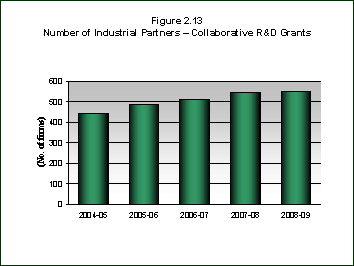
Some of the findings from a recent evaluation of the Networks of Centres of Excellence program (report is available at http://www.nce-rce.gc.ca/pubs_e.htm) were:
- While many of the positive outcomes of the NCE Program are shared with other network-related programs, it performs better than these programs in some key areas, such as the creation of structured networks, the establishment of intersectoral partnerships, and knowledge utilization — in particular, the commercialization of research findings. Clearly, there is an undisputed place for the NCE Program.
- NCE networks have been successful at bringing together researchers, public sector and private sector representatives, and NGOs to contribute to the definition of key knowledge issues, the execution of research and the translation of research findings into actionable results.
- Networking and collaboration programs double the amount of knowledge transfer activities and increase knowledge utilization significantly according to researchers.
Program Activity Support Commercialization
| Description: This program activity supports innovation and promotes the transfer of knowledge and technology to Canadian companies. | ||
|---|---|---|
| Expected Result: The transfer of knowledge and technology residing in Canadian universities and colleges to the user sector is facilitated. | ||
| Indicator | Results | Performance Status |
|
|
|
| Financial Resources ($ millions) 2008-09 |
Human Resources (Full-Time Equivalents) 2008-09 |
||||
|---|---|---|---|---|---|
| Planned Spending |
Total Authorities |
Actual Spending | Planned | Actual | Difference |
| 14.0 | 14.4 | 15.6 | 4 | 10 | +6 |
The key programs under this program activity are:
- Intellectual Property Mobilization (IPM) Program: The objective of this program is to accelerate the transfer of knowledge and technology residing in Canadian universities and hospitals for the benefit of Canada. The IPM program provides funding in partnership with universities to support activities related to managing and transferring intellectual property resulting from publicly funded research performed at universities.
- Idea to Innovation (I2I) Program: I2I accelerates the pre-competitive development of promising technologies and promotes its transfer to Canadian companies. The program supports R&D projects with recognized technology-transfer potential by providing crucial assistance to university researchers in the early stages of technology validation and market connection.
Statistics Canada currently conducts a survey of intellectual property (IP) commercialization in the university sector every year. The key results from the first six surveys are highlighted in Figure 2.18. The survey data are confidential and it is therefore impossible to link the outcomes in the figure below to NSERC funding. However, from NSERC’s analysis of patents and publications, it is highly likely that the majority would be attributable to NSERC funding (all NSERC funding and not just the programs under this program activity). The sizeable increases seen over the six-year period for most of the commercialization activities presented is a positive result.
| Commercialization Activity | 1999 | 2001 | 2003 | 2004 | 2005 | 2006 |
|---|---|---|---|---|---|---|
| Inventions disclosed | 829 | 1,105 | 1,133 | 1,432 | 1,452 | 1,356 |
| Inventions protected | 509 | 682 | 597 | 629 | 761 | 707 |
| New patent applications | 616 | 932 | 1,252 | 1,264 | 1,410 | 1,442 |
| Patents issued | 325 | 381 | 347 | 397 | 374 | 339 |
| Total patents held | 1,826 | 2,133 | 3,047 | 3,827 | 3,961 | 4,784 |
| New licences | 218 | 320 | 422 | 494 | 621 | 437 |
| Total active licences | 1,109 | 1,338 | 1,756 | 2,022 | 2,836 | 2,038 |
| Royalties from licensing ($M) | $18.9 | $52.5 | $55.5 | $51.2 | $55.2 | $59.7 |
| Total spin-off companies | 454 | 680 | 876 | 968 | 1,027 | 1,103 |
| Source: Statistics Canada |
By way of example of university spin-off companies, NSERC engages in a detailed biannual study to uncover firms that were created based on university research. The start-up companies uncovered have all been founded on results of research funded partially by NSERC. The 154 start-up companies featured in Figure 2.15 are currently in the business of producing goods and services for Canadian and international markets. Combined, these companies employ nearly 18,000 Canadians and generate $3.9 billion in annual sales/revenue.
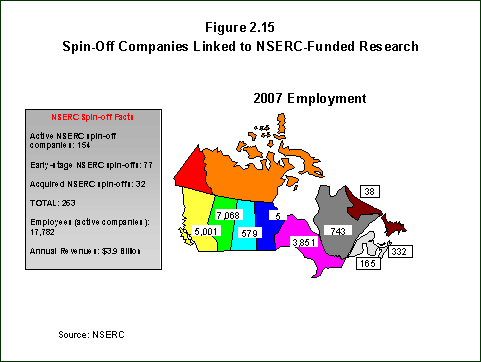
Section 3:
Supplementary Information
3.1 Financial Highlights
For the Period ending March 31, 2009
Condensed Statement of Financial Position
| (in thousands of dollars) | Percentage Variance | 2009 | 2008 |
|---|---|---|---|
| Total Assets | -0.1% | 11,878 | 11,895 |
| Total Liabilities | 8.1% | 12,210 | 11,297 |
| Total Equity | -155.5% | (332) | 598 |
| Total Liabilities & Equity | -0.1% | 11,878 | 11,895 |
For the Period ending March 31, 2009
Condensed Statement of Operations
| (in thousands of dollars) | Percentage Variance | 2009 | 2008 | |
|---|---|---|---|---|
| Expenses | Total Expenses | 1.8% | 1,036,116 | 1,017,435 |
| Revenues | Total Revenues | -25% | 3 | 4 |
| NET COST OF OPERATIONS | 1.8% | 1,036,113 | 1,017,431 |
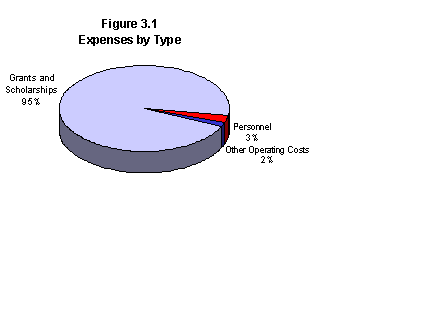
Figure 3.1 summarizes NSERC’s expenditures by category of expenditure for 2008-09. NSERC’s administration costs are approximately five per cent of its total budget, which is low compared to similar agencies in Canada and around the world.
Financial Statements
NSERC’s audited financial statements for the year ending March 31, 2009 can be found on-line at:
NSERC Financial Statements, 2008-09
3.2 List of Tables
The following tables are available on-line: www.tbs-sct.gc.ca/dpr-rmr/st-ts-eng.asp
Table 1: Sources of Non-e Revenue
Table 2: Details on Transfer Payment Programs (TPPs)
Table 3: Internal Audits and Evaluations
- Date modified: